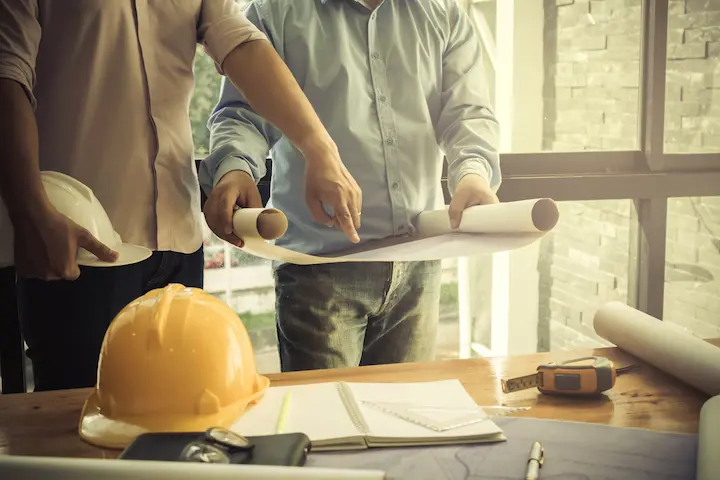Whether you are planning to construct a commercial warehouse, an industrial facility, or even a residential structure, understanding the intricate world of building codes is crucial. Steel buildings have gained immense popularity over recent years due to their durability, versatility, and cost-effectiveness. However, navigating the maze of regulations and standards can be overwhelming, especially if you’re new to the industry.
Our steel building experts at Champion Buildings are here to help– whether you’re a seasoned architect, a curious homeowner, or a construction professional seeking guidance, this comprehensive guide will demystify the world of building codes for steel buildings and provide practical tips for navigating the steel building code compliance process.
What are Building Codes?
Building codes are a set of regulations and standards established by local, regional, or national authorities as well as the metal building industry to ensure the safety, structural integrity, and overall quality of buildings. These codes provide guidelines and requirements that govern various aspects of construction, including materials, design, construction methods, electrical systems, plumbing, fire safety, accessibility, and more.
Purpose of Building Codes for Steel Buildings
The purpose of local building codes for steel buildings, specifically, is to address the unique considerations and characteristics of structures made primarily from steel. A prefab metal building offers numerous advantages such as strength, durability, and versatility, but they also present specific challenges that need to be addressed to ensure safe and efficient construction.
Building codes for a new metal building serve several essential purposes, such as:
- Promote the safety of occupants
- Protect public welfare by setting standards for:
- structural stability
- fire resistance
- resistance to natural disasters such as earthquakes and hurricanes
- Ensure that buildings meet essential health and sanitation requirements, including:
- ventilation
- plumbing
- electrical safety.
- Maintain consistency and quality in each construction project
Benefits of Adhering to Building Codes
Adhering to building codes offers numerous benefits, including:
- Safety assurance for occupants, reducing the risk of accidents, injuries, and property damage.
- Structural integrity and resilience against natural disasters such as earthquakes, hurricanes, and high winds.
- Consistency and standardization in construction practices by building professionals, ensuring quality and uniformity.
- Streamlined construction process by providing clear guidelines and requirements.
- Cost-effective construction through efficient decision-making and reduced rework.
- Compliance with legal requirements, avoiding penalties and potential legal action.
- Insurance coverage eligibility and potentially reduced insurance premiums.
- Enhanced consumer protection by ensuring buildings meet minimum safety and quality standards.
- Long-term durability and performance of the steel structure.
- Promotion of sustainable and energy-efficient construction practices.
- Facilitation of proper maintenance and inspection of steel buildings over time.
- Confidence and trust-building among stakeholders, including architects, engineers, contractors, and property owners.
Steps Involved in Obtaining a Building Permit
Let’s go over the steps involved in obtaining a metal building permit.
Researching Local Metal Building Regulations
- Familiarize yourself with whether you need a building permit for your new construction, as well as specific building permit requirements.
- Consult the local building department or relevant authorities to obtain the necessary information regarding metal building permits, building permit cost, zoning permit and restriction details, setback regulations, and other specific guidelines for the steel construction permitting process.
Submitting Building Permit Application
- Complete the building permit process by filling out the application form provided by the local building department.
- Gather all required documents, which may include architectural drawings, structural plans, engineering calculations, site plans, and any additional information specified by the authorities or your metal building supplier.
- Prepare any supporting documentation, such as proof of property ownership or required permits from other agencies (if applicable).
- Pay the applicable fees associated with the permit application.
Review and Approval Process:
- Once the building permit application is submitted, it undergoes a review process by the local building department.
- The review may involve multiple departments, such as planning, zoning, structural engineering, fire safety, and others, depending on the specific requirements and regulations in your area.
- During the review process, the authorities will assess the submitted plans and documents for compliance with building codes, safety standards, and other applicable regulations.
- They may request revisions or additional information if necessary.
Issuance of Building Permits
- If the building department approves the permit application and finds it compliant with the regulations, they will issue the building permit.
- The permit will specify the approved scope of work, construction conditions, and any special requirements or restrictions.
- Ensure that you receive a copy of the building permit, as it needs to be displayed at the construction site throughout the building process.
Inspection Requirements
- As construction progresses, inspections will be scheduled at various stages to ensure compliance with the approved plans and building codes.
- Contact the local building department to request inspections as required by the permit and arrange for inspections at key milestones, such as foundation, framing, electrical, plumbing, and final inspections.
- The inspections may include a review of the steel structure, foundation, electrical systems, plumbing, fire safety measures, and other relevant components.
Building Codes and Compliance for Metal Buildings
Building codes and compliance play a critical role in ensuring the safety and structural integrity of metal buildings. Here’s an overview of the applicability of building codes to metal buildings and specific code requirements to consider.
Applicability of Building Codes to Metal Buildings
Building codes fall into two categories: general codes and specific codes for building type– in this case, metal buildings.
General Building Codes
Most jurisdictions have general building codes that apply to all types of structures, including metal buildings. These codes cover areas such as structural design, fire safety, electrical systems, plumbing, accessibility, and energy efficiency.
Specific Metal Building Codes
Some jurisdictions have specific codes or standards that address the unique considerations of metal buildings. These codes may provide guidelines for structural systems, materials, connections, corrosion protection, and other aspects specific to metal construction.
Specific Building Code Requirements for Metal Buildings
When it comes to steel building structures, the following specifications for code requirements exist.
Structural Design
Building codes specify requirements for the structural design of metal buildings, including load calculations, wind and seismic resistance, foundations, and framing systems. These requirements ensure the building can withstand expected loads and environmental conditions.
Fire Safety
Codes include provisions for fire resistance, fire protection systems (such as sprinklers), and means of egress in case of fire. Fire-resistant materials, such as fire-rated wall assemblies and roof systems, may be required depending on the building’s occupancy type and size.
Electrical and Plumbing Systems
Building codes govern the installation of electrical and plumbing systems in metal buildings. They establish standards for wiring, outlets, fixtures, piping, drainage, and ventilation to ensure safe and efficient operation.
Insulation and Energy Efficiency
Codes often mandate minimum insulation requirements to promote energy efficiency in metal buildings. These requirements address factors such as thermal performance, air leakage, and steel building insulation placement to optimize energy usage and occupant comfort.
Corrosion Protection
Metal buildings are subject to potential corrosion due to exposure to moisture or harsh environments. Some codes may require corrosion-resistant coatings, galvanized steel, or other protective measures to ensure the longevity and structural integrity of the metal components.
Wind and Seismic Resistance
Building codes include provisions for wind and seismic resistance, taking into account the specific design criteria for metal buildings. This ensures that the structures can withstand the forces exerted by high winds or seismic events in the designated region.
Accessibility
Codes address accessibility requirements for individuals with disabilities. They outline guidelines for accessible entrances, ramps, doorways, restrooms, parking spaces, and other facilities within metal buildings to ensure equal access and usability for all occupants.
Common Challenges in Building Code Compliance for Steel Buildings
Building code compliance for steel buildings can present several challenges. The key to overcoming these challenges involves proactive engagement, collaboration, and a comprehensive understanding of the specific code requirements for steel buildings.
Lack of Awareness and Knowledge
Architects, engineers, contractors, and even property owners may not be fully familiar with the intricacies of the codes and may unintentionally overlook or misunderstand certain requirements. Staying updated with the latest codes and engaging professionals experienced in steel construction can help address this challenge.
Cost and Time Implications
Adhering to specific code requirements, such as fire resistance measures, insulation, or corrosion protection, can increase construction costs. Moreover, seeking code approvals, conducting inspections, and making any necessary modifications can prolong the construction timeline. Balancing code compliance with project budgets and schedules requires careful planning and coordination.
Dealing with Design and Construction Limitations
Steel buildings have unique design and construction considerations, including constraints related to span lengths, column spacing, roof slope, foundation requirements, and more. Meeting code requirements while optimizing the design and ensuring structural integrity can be challenging.
Accessibility and Universal Design
Incorporating accessible entrances, pathways, restrooms, and other amenities in steel buildings can present challenges due to the nature of steel construction. Balancing aesthetics, functionality, and compliance with accessibility requirements is crucial to address this challenge.
Evolving Code Standards
Staying abreast of the latest code editions, amendments, and local interpretations can be challenging. Ensuring ongoing compliance throughout the construction process and even after the completion of the building requires continuous monitoring and adapting to evolving code standards.
Partner with Champion Buildings for Expert Guidance and Quality Steel Structures
Are you planning to construct a steel building and in need of expert guidance and top-quality structures? Partner with Champion Buildings, your trusted ally in the world of steel building construction. With years of experience and a track record of excellence, our metal building specialists offer a wide range of services to construct prefabricated metal buildings on your property.
Our team of seasoned professionals understands the complexities of building codes, compliance, and the nuances of steel construction– whether you are building a metal pole barn, a steel garage, a metal workshop building, or a commercial steel structure, we are committed to providing you with expert guidance every step of the way.
Contact us today to get started on your steel building construction by calling us at (800) 942-6812 or filling out the contact form below.


